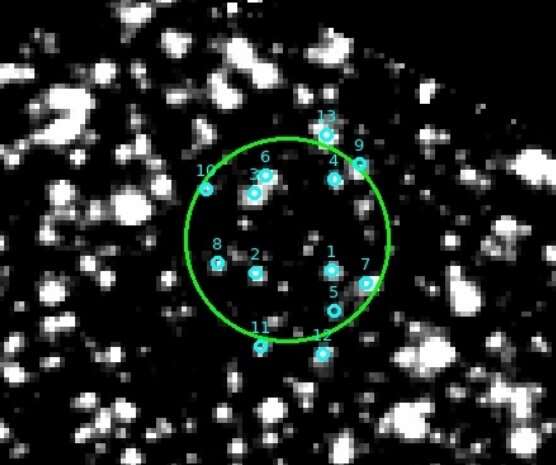Combined (F606W+F814W) HST ACS/WFC optical image around the Chandra position of SSS1 (green circle with 1'' radius). The sources indicated by cyan circles in the region have magnitudes between 25 and 27 mag. Credit: Carpano et al., 2019.
Astronomers from Max Planck Institute for Extraterrestrial Physics in Germany have observed a new outburst from SSS1, a luminous transient supersoft X-ray source in the nearby galaxy NGC 300. The newly detected event could shed more light on the nature of this mysterious transient. The finding is detailed in a paper published October 18 on arXiv.org.
Luminous supersoft X-ray sources (SSSs) are sources emitting only low energy (soft) X-rays (between 0.9 and 2.5 keV). They have a characteristic blackbody temperature of a few tens of eV and a bolometric luminosity of about 100 undecillion erg/s. The radiation that these sources emit is highly ionizing and is readily absorbed by the interstellar medium (ISM). It is estimated that there are thousands of SSSs in the disks of ordinary spiral galaxies.
Some SSSs were found to have a bolometric luminosity of even more than 1,000 undecillion erg/s and exhibit strong thermal X-ray emission below 1.0 keV with little or no flux observed at higher energies. Such objects, known to be relatively rare, were dubbed ultraluminous supersoft sources (ULSs).
Located some 6.13 million light years away, NGC 300 is a face-on spiral galaxy hosting at least two luminous transient supersoft X-ray sources, designated SSS1 and SSS2. Identified for the first time during a 1992 outburst as a ULS, SSS1 is a recurrent source with a bolometric luminosity over 100 undecillion erg/s. The next outbursts of SSS1 occurred in 2000 and 2008.
Now, a group of astronomers led by Stefania Carpano reports the detection of another outburst from this source. By analyzing the data from ESA's XMM-Newton spacecraft, that the new event took place in December 2016.
"We report here the detection of a new outburst from this source, which occurred during two more recent XMM-Newton observations performed on December 17 to 20, 2016, lasting for 310 ks," the astronomers wrote in the paper.
Results of the observations of the 2016 outburst reveal a bolometric luminosity of SSS1 at a level superior or equal to 300 undecillion erg/s. Based on the analysis of the 0.2−2.0 keV light curve of this source, the astronomers detected a periodic modulation with a period of approximately 4.68 hours. This period could be associated with an orbital modulation, although the signal strength is highly variable, and previous studies, like the one conducted in 2001, show different results (a period of around 5.7 hours). Therefore, this assumption requires further verification.
The detection of the new outburst suggests a possible recurrence period of about eight years for such events in SSS1. However, more regular observations of NGC 300 with a highly sensitive instrument are needed to confirm this prediction.
According to the authors of the paper, the results suggest that SSS1 could be a recurrent nova. Such objects undergo supersoft X-ray phases with luminosities close to the Eddington limit for a massive white dwarf and may exhibit outbursts occurring periodically. The second most plausible hypothesis taken account by the researchers is that the source is a ultraluminous X-ray source (ULX) binary system viewed at high inclination angle. In that type of objects, the soft photons would come either from a disk outflow or from a geometrically thick disk.
More information: New outburst from the luminous supersoft source SSS1 in NGC 300 with periodic modulation, arXiv:1910.08314 [astro-ph.HE] arxiv.org/abs/1910.08314
© 2019 Science X Network
























